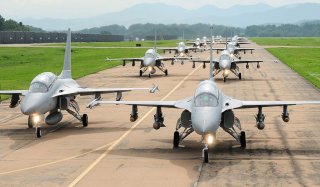Did Coronavirus Wipe Out Argentina’s New Fighter Jet Order?
What went wrong with its FA-50 order?
The Argentine air force just can’t catch a break.
A year after the struggling Latin American air arm selected South Korea’s FA-50 light fighter as its new main warplane, the deal reportedly is on hold, the latest victim of the coronavirus pandemic.
Korea Aerospace Industries on April 6, 2020 announced that its plan to build FA-50s for Argentina “has been put on hold as the coronavirus outbreak is dealing a huge blow,” according to The Korea Herald.
The economic chaos resulting from the pandemic apparently has compelled Buenos Aires to reconsider its spending priorities. The FA-50 contract apparently still was under negotiation and Argentina reportedly will end those talks.
“It must have been difficult for Argentina to spend its defense budget for fighter jets when it is experiencing difficulties due to the virus spread,” a KAI official said.
The Argentine air force back in July 2019 selected the FA-50 as its next fighter. The decision was good news for a once-proud air arm that, in recent years, has precipitously declined in size and effectiveness.
Argentine officials as early as 2016 had asked to evaluate the twin-seat, supersonic FA-50, Jane’s reported.
The air force could have acquired as many as ten FA-50s, according to Argentine media. The twelve-ton fighter retails for around $30 million per copy, tens of millions of dollars less than the cost of a new F-16 or similar, heavier fighter.
The Argentine air force badly needs new warplanes. British forces in 1982 shot down around a third of Argentina’s 400 warplanes, but in subsequent decades funding woes and mismanagement have exacted an even greater toll.
By late 2015 the Argentine air force and navy together could muster fewer than 250 warplanes including a few Vietnam War-vintage, subsonic A-4s and equally aged, but supersonic, French-made Mirages. Even the planes that could fly lacked modern systems.
“The entire air force fleet lacks modern avionics and systems, and still uses analog equipment,” Santiago Rivas wrote in a 2015 edition of Combat Aircraft magazine. “Aircraft have missed out on self-protection equipment, including radar warning receivers, chaff/flare dispensers and so forth.”
“Critically, only the A-4s have an aerial refueling capability and there are just two tankers. [Airborne early warning] capability is nonexistent,” Rivas added, “despite the fact that controlling the airspace of such a large country is a major and vital task.”
The Mirages left service in mid-2015. To rebuild its supersonic fighter capability, Buenos Aires considered buying new Gripens from Brazil, old American F-16s, second-hand Mirage F.1s from Spain and new FC-1s from China before finally settling on forteen used Israeli Kfir Block 60s, priced to move at $350 million including several years of maintenance.
It seemed like the air force might be on the rebound. But not everyone was happy, especially Brig. Gen. Mario Roca, who in late 2015 was the air force’s number-three officer. Roca argued that the Israeli fighters lacked a modern weapons system. Only six of them would be equipped with radars, he pointed out.
In any event, the United States refused to grant an export license for the Kfir’s American-made engines and so Argentina was left with no supersonic fighters.
By 2018 Argentina also had retired all of its A-4s. The flying branch had wanted to upgrade the fighters to serve until 2022, but a lack of spares rendered them unflyable.
Today just a handful of weapons-capable warplanes remain in Argentine service, including around two dozen each subsonic IA-63 attack jets and IA-58 counterinsurgency planes. But the IA-58s also are slated for imminent retirement.
The FA-50s could have helped the air force to begin rebuilding. The navy meanwhile began its own rearmament program. Five ex-French navy Super Etendard fighters in May 2019 arrived at the port of Bahia Blanca in Argentina.
The subsonic fighter-bombers eventually will equip a navy squadron and, by the end of 2020, could be the most sophisticated warplanes in the Argentine military. The FA-50s would have exceeded them in speed, firepower and sophistication.
The Super Etendards in question originally entered service with the French navy in the late 1970s or early 1980s. The French in the 1990s upgraded the carrier-capable jets to the Super Etendard Modernize standard before retiring them in 2016.
The Argentine navy previously operated fourteen Super Etendards, acquiring five of them in time for service during the 1982 Falklands War. During that conflict, the Argentine Super Etendards fired Exocet anti-ship missiles and sank two British vessels, a destroyer and a cargo ship.
By late 2017 none of the original Super Etendards were flightworthy, according to Flight’s 2018 survey of world air arms.
In the context of the Argentine military’s long unilateral disarmament, acquiring ten new FA-50s and five old Super Etendards was a big deal. Now that the FA-50 deal is on hold, the refurbished Super Etendards arguably are the Argentine military’s most important recent acquisitions.
David Axe is defense editor of The National Interest. He is the author of the graphic novels War Fix, War Is Boring and Machete Squad.
Image: Wikimedia.

